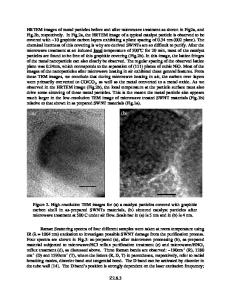Effect of Power Level on the Processing of Ni-Based Casting Through Microwave Heating
In the present research, Ni-based powder casting was developed using a domestic microwave oven with a variable power level of 180–900 W at 2.45 GHz frequency. The power level and exposure time were optimized using a set of experiments. It was found that w
- PDF / 501,718 Bytes
- 9 Pages / 439.37 x 666.142 pts Page_size
- 59 Downloads / 289 Views
Abstract In the present research, Ni-based powder casting was developed using a domestic microwave oven with a variable power level of 180–900 W at 2.45 GHz frequency. The power level and exposure time were optimized using a set of experiments. It was found that with increase in power level the exposure time for the development of casting was reduced. The casting was developed within 25 min of exposure time at 900 W of power. Further, the microstructural results revealed the formation of equiaxed grains throughout the casting. The XRD analysis revealed the intermetallic compounds formation during processing. The intense heating led to the formation of nickel silicides and some chromium carbides. The formed carbides precipitated along the grain boundaries as indicated by EDS analysis. The microhardness of developed casting was observed as 404 ± 52 HV and was due to the presence of hard intermetallic compounds. Keywords Microwave heating · Metal powder casting · Nickel · Microstructure · XRD
1 Introduction Material processing industries are looking for green, eco-friendly, and sustainable techniques of manufacturing to reduce the global warming effect. The environmental friendly manufacturing techniques are currently focused research areas for academicians, scientists, and researchers. Casting is one of the universally adopted manufacturing techniques throughout the world and is used to manufacture a variety of material components. However, the conventional casting methods are characterized
G. Singh · Dinesh · S. Kaushal (B) Gulzar Group of Institutes, Ludhiana, Punjab, India e-mail: [email protected] S. Singh The NorthCap University, Gurugram 122017, India © Springer Nature Singapore Pte Ltd. 2021 P. M. Pandey et al. (eds.), Advances in Production and Industrial Engineering, Lecture Notes in Mechanical Engineering, https://doi.org/10.1007/978-981-15-5519-0_33
445
446
G. Singh et al.
by higher processing time, lower efficiency, high energy consumptions, and pollution generation. Many government organizations are restricting and penalizing such industries to reduce the pollution and energy conservations. In recent decade, material processing through microwave energy has evolved as an environmental friendly method [1, 2]. Microwave energy is associated with the property of volumetric heating, which allows the heating at the molecular levels and also reduces the thermal gradient which commonly occurs in case of conventional heating processes. Apart from this volumetric heating, the microwave processing of materials results in the reduction in processing time, less energy consumption, and excellent structure–property relations of the material being processed [3, 4]. Earlier, the microwave heating applications were only limited to the processing of ceramic materials due to the misconception that metallic materials do not absorb the microwaves; however, Roy et al. [5] carried out the successful sintering of metallic powders through microwave heating. This investigation further encouraged the researchers to
Data Loading...










